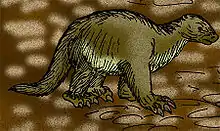Pliometanastes
Pliometanastes is an extinct genus of giant ground sloths of the family Megalonychidae endemic to North America during the Late Miocene epoch through very early Pliocene epoch (Hemphillian in the NALMA classification). Its fossils have been found in Costa Rica and across the southern United States from California to Florida.[1]
| Pliometanastes | |
|---|---|
| Scientific classification | |
| Kingdom: | |
| Phylum: | |
| Class: | |
| Order: | |
| Infraorder: | |
| Family: | |
| Genus: | †Pliometanastes Hirschfeld & Webb 1968 |
| Species | |
| |
Description
Pliometanastes and Thinobadistes were the first of the giant sloths to appear in North America, the former around 9 million years ago.[2] Both were in North America before the Panamanian Land Bridge formed around 2.7 million years ago, which led to the main pulse of the Great American Interchange. It is then reasonable to presume that the ancestors of Pliometanastes island-hopped across the Central American Seaway from South America, where ground sloths arose.[3]
Pliometanastes gave rise to Megalonyx. Their closest extant relatives, based on molecular results (which clash with earlier conclusions derived from morphology) are the extant arboreal three-toed sloths (Bradypus).[4][5]
Taxonomy
Pliometanastes was named by Hirschfeld and Webb (1968). Its type is Pliometanastes protistus. It was assigned to Megalonychidae by Hirschfeld and Webb (1968) and Carroll (1988).[6][7]
Fossil distribution
Sites and ages of specimens (not complete list):
- Withlacoochee River Site 4A, Marion County, Florida ~10.3-4.9 Ma
- Haile Site V/XIXA, Alachua County, Florida ~10.3-4.9 Ma
- Box T, Lipscomb County, Texas ~23-5.3 Ma
- Klipstein Ranch site 3, Kern County, California ~23-5.3 Ma
- Curré Formation, Costa Rica
References
- "Pliometanastes". Paleobiology Database. Retrieved 2011-07-16.
- Tedford, R.H.; Albright, L.B.; Barnosky, A.D.; Ferrusquaia-Villafranca, I.; Hunt, R.M.; Storer, J.E.; Swisher, C.C.; Voorhies, M.R.; Webb, S.D.; Whistler, D.P. (21 April 2004). "Mammalian Biochronology of the Arikareean Through Hemiphilian Interval (Late Oligocene Through Early Pliocene Epochs)". In Woodburne, M.O. (ed.). Late Cretaceous and Cenozoic Mammals of North America: Biostratigraphy and Geochronology. Columbia University Press. pp. 169–231, see also p. 337. ISBN 978-0231503785. OCLC 880404891.
- Tetrapod Zoology Archived 2011-03-18 at the Wayback Machine, Scienceblogs, Ten things you didn't know about sloths, by Darien Naish, University of Portsmouth January 23, 2007.
- Presslee, S.; Slater, G. J.; Pujos, F.; Forasiepi, A. M.; Fischer, R.; Molloy, K.; Mackie, M.; Olsen, J. V.; Kramarz, A.; Taglioretti, M.; Scaglia, F.; Lezcano, M.; Lanata, J. L.; Southon, J.; Feranec, R.; Bloch, J.; Hajduk, A.; Martin, F. M.; Gismondi, R. S.; Reguero, M.; de Muizon, C.; Greenwood, A.; Chait, B. T.; Penkman, K.; Collins, M.; MacPhee, R.D.E. (2019). "Palaeoproteomics resolves sloth relationships" (PDF). Nature Ecology & Evolution. 3 (7): 1121–1130. doi:10.1038/s41559-019-0909-z. PMID 31171860. S2CID 174813630.
- Delsuc, F.; Kuch, M.; Gibb, G. C.; Karpinski, E.; Hackenberger, D.; Szpak, P.; Martínez, J. G.; Mead, J. I.; McDonald, H. G.; MacPhee, R.D.E.; Billet, G.; Hautier, L.; Poinar, H. N. (2019). "Ancient Mitogenomes Reveal the Evolutionary History and Biogeography of Sloths". Current Biology. 29 (12): 2031–2042.e6. doi:10.1016/j.cub.2019.05.043. PMID 31178321.
- S. E. Hirschfeld and S. D. Webb. 1968. Bulletin of the Florida State Museum 12(5)
- R. L. Carroll. 1988. Vertebrate Paleontology and Evolution. W. H. Freeman and Company, New York 1-698

